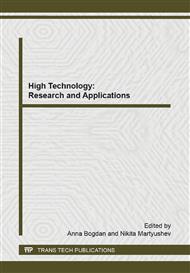[1]
A.A. Burenin and L.V. Kovtanyuk Determination of an elastic-plastic process on the basis of the resultant unloaded state, Mech. Solids. 41 (3), 103-106 (2006).
Google Scholar
[2]
M.V. Polonik, E.E. Rogachev On the removal of residual stresses in the elastic-plastic medium for example a hollow sphere. XXXVI Far Eastern Mathematical Workshop Academician E.V. Zolotov, 4-10 September. 2012, Vladivostok: compendium. (Electronic resource). Vladivostok: IACP – 2012. S. 175–177. Volume of 600 MB, 1 opt. CD-ROM (CD-ROM). (In Russian).
Google Scholar
[3]
A.A. Burenin, L.V. Kovtanyuk, M.V. Polonik, The possibility of reiterated plastic flow at the overall unloading of an elasto-plastic medium, Doklady Physics. 45(2000) 694–696.
DOI: 10.1134/1.1342452
Google Scholar
[4]
A.A. Burenin, L.V. Kovtanyuk, M.V. Polonik, The formation of a one-dimensional residual stress field in the medium of a cylindrical defect in the continuity of an elasto-plastic medium, Journal of Applied Mathematics and Mechanics. 67(2003).
DOI: 10.1016/s0021-8928(03)90014-1
Google Scholar
[5]
A.A. Burenin, L.V. Kovtanjuk, I.A. Terletskiy To the Formation of Residual Stress Field in the Vicinity of a Spherical Cavity Viscoelastoplastic Material, Far Eastern Mathematical Journal. 12, 2 (2012) 146–159.
Google Scholar
[6]
E.V. Murashkin, M.V. Polonik Development of approaches to the creep process modeling under large deformations, Applied Mechanics and Materials. 249–250 (2013) 833–837.
DOI: 10.4028/www.scientific.net/amm.249-250.833
Google Scholar
[7]
E.V. Murashkin, M.V. Polonik Determination of a Loading Pressure in the Metal Forming by the Given Movements, Advanced Materials Research. 842 (2014) 494–499.
DOI: 10.4028/www.scientific.net/amr.842.494
Google Scholar
[8]
A.M. Lokoshchenko Process modeling creep and stress rupture of metals. M.: MSIU. 2007. (In Russian).
Google Scholar
[9]
G. Carslaw, G. Jaeger Thermal conductivity of solids. Nauka Moscow, 1964. (In Russian).
Google Scholar
[10]
Physical quantities. Handbook (edited by I.S. Grigoriev, E.Z. Meylthova). M.: Energoatomizdat. 1991. (In Russian).
Google Scholar
[11]
S. Taira, R. Ohtani Theory of high-temperature strength materials – Translated from the Japanese. Metallurgia Publ., Moscow, 1986. (In Russian).
Google Scholar


